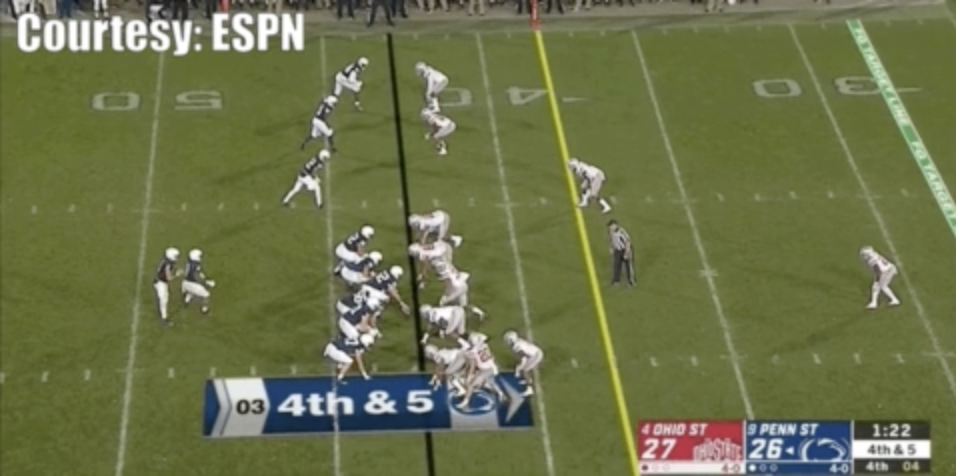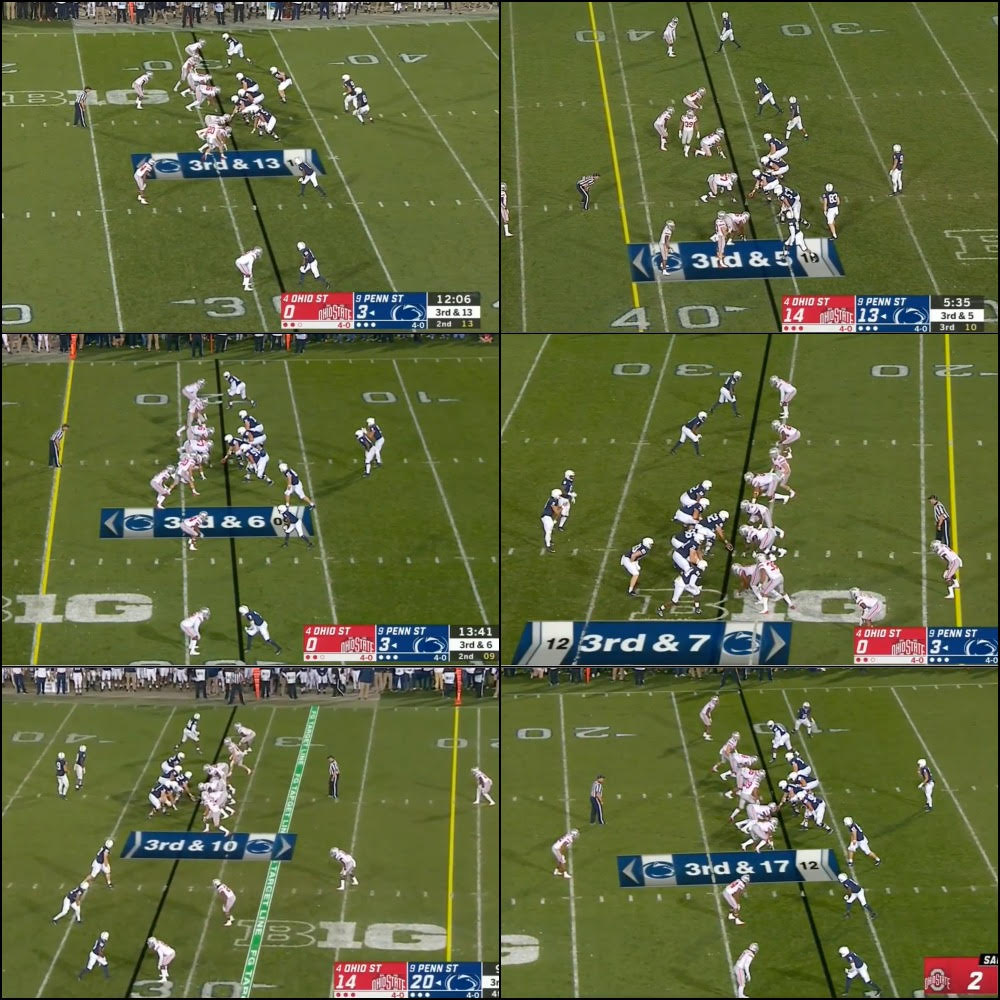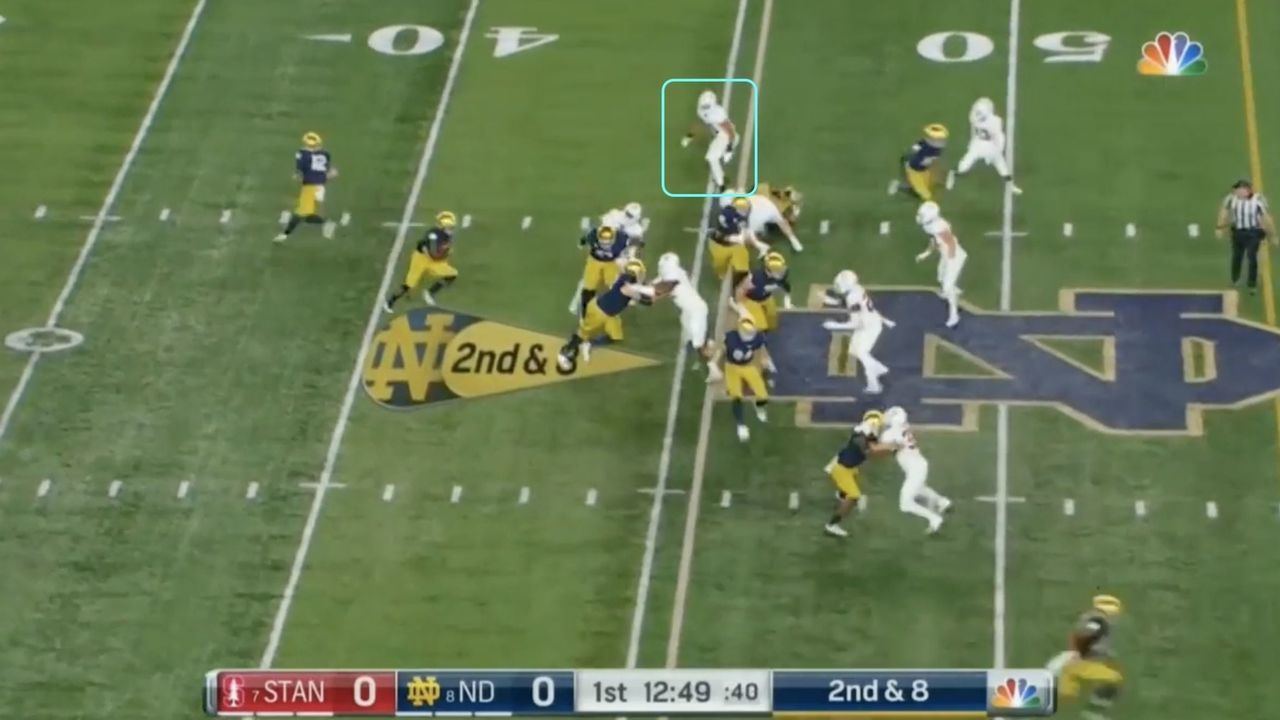Week 5 Film Study: OSU gets creative vs. Penn State, Florida's defense is legit
Here's a look at some of the more intriguing film-related developments from Week 5 of the college football season:
Ohio State’s screen game sinks Penn State
Ryan Day deserves credit for how he helped shape Ohio State's offense throughout the Penn State game. He had to work with a new quarterback and through early offensive struggles in a hostile environment.
In this scenario, Urban Meyer usually commands his team to rely on the quarterback run game; make it a one-on-one contest and trust his guys to be better than the opposition.
He couldn’t do that on Saturday, however - Dwayne Haskins isn’t that type of quarterback. And Penn State proved, once again, it has elite, playoff-caliber team speed on defense.
The Buckeyes struggled to move the ball on the ground, averaging 3.2 yards per rush attempt, accumulating only 26 yards in the first quarter. Haskins looked unsettled. He missed open throws and forced balls where he shouldn’t have; he dropped his eyes and became more reckless.
Seeing this play out, Day adjusted. He began to use Penn State’s pressure packages and speed against itself. OSU ran screens toward the blitz, catching Penn State with a tunnel screen on three different occasions:
Although most were disguised blitzes, Day and OSU hit Penn State over the head with the same design so consistently, it felt like the Buckeyes had a tell.
Other blitzes were more obvious. Penn’s linebackers would encroach on the line of scrimmage, and Day routinely called the perfect play:
Although it worked, the Buckeyes didn’t block the above play well. It’s a basic screen: the line fakes a pass play, then leaks out into space, with the running back following in behind.
The job of the blockers is to hit certain landmarks and play with a specific leverage. One clears the “sidewalk,” getting to the hash mark and flipping his hips toward the goal posts, and another clears the “alley,” working from the numbers toward the sideline. The final blocker “runs the train” and works between the alley and sidewalk while clearing out any debris before the running back comes hustling through.

The perimeter blocker hit the wrong landmark. The O-lineman setting the sidewalk missed his man, and the defender read the play well. The final blocker made the play sing, bailing out his receiver and clearing just enough room for J.K. Dobbins to get into the end zone.
By the fourth quarter, Penn State's defense started to make simple mistakes. Ohio State’s big, game-winning drive came down to two huge screens.
The first was an explosive play, backed up against their own end zone, on the same design as before. This time, the blocking mechanics were better:
The second, a touchdown on the most basic of bubble screens. The Buckeyes receiver made a play; Penn State’s DB didn’t:
It takes smart coaching to figure out what’s going wrong, in real time, and adjust on the fly. Haskins deserves praise for his fourth-quarter performance, but let’s not go overboard about his clutch factor. Much of his yardage came thanks to good play-calling and designs; the touchdowns were a result of his players making plays in space.
About that final play call
By now, you’ve heard the reaction to the final play in the PSU-OSU game.
"I was upset with (the play call) because there was a particular thing that I should have foreseen and I didn't," Penn State offensive coordinator Ricky Rahne told The Associated Press. "I should have foreseen one other thing, and I didn't. That made it a little bit more difficult than I thought it was going to be."
What he didn’t foresee was Ohio State stunting Chase Young inside and dropping out its safety from the middle of the line of scrimmage. Rahne wanted to run at that defender or throw a quick screen outside.
Watch the setup before the snap:

Penn State shuffled its running back across the formation in a bid to out-leverage Ohio State’s defenders - the two at the bottom of the screen, and the linebacker over the center.
At the last second, the Buckeyes countered with some shuffling of their own, moving all three defenders to maintain the balance of the formation. That wreaked havoc on the blocking mechanics for the play, a basic inside-zone read. Young was left unblocked as he careened in off the edge.
I understand the result was poor. Would I have handed the ball to Trace McSorley and called a play that had the option to throw or run the ball? Of course - he’s Penn State’s best player. In big moments, you have to think players, not plays.
But I don’t think the process was as bad as we think, we’re playing the result.
Everything Penn State does is a box RPO, followed by a post-snap read. McSorley reads the box count and flips between a pass and run play. If it’s a run, there’s almost always an option for him to throw the ball. Often times, there’s a hold-fold read: if defender X holds his position, throw the ball. If not, keep it.
What I don’t understand, is why, presented with that front, McSorley didn’t flip the ball outside to the tagged bubble screen. Now, it would've been an easy read for Ohio State’s slot corner, but it would've still been a one-on-one play in space, as opposed to running the ball into a mosh pit.
Rahne’s comments strike me as someone protecting his best player.
OSU’s linebacker movement baffles PSU
We’ve dissected Penn State’s final play-call. But how about the rest of the game?
James Franklin’s team struggled to move the ball all night. They were 3-for-17 on third downs, including a 1-for-12 mark through the first three quarters.
On the other side of the ball, Greg Schiano’s defense deserves recognition. There were a ton of plays that came down to Ohio State’s front out-battling Penn State’s offensive line.
On third downs, Schiano got creative. Ohio State, along with rivals Michigan, have been toying with the alignment and makeup of its linebackers for a couple of years. Most resemble safeties now and they’re moved all over the field.
Check out some of these looks:

That’s every single look or front you can imagine being chucked at McSorley. We’re talking double-eagle, five-across, split-front, widening the front, stacked fronts, and vacating the middle of the field. It’s anybody’s guess, at any time, who is rushing the passer and who is dropping.
For an offense built around reading the box pre- and post-snap, it was suffocating.
Rahne didn’t just get beat on that final play-call, he got whooped by Schiano all night long.
Florida’s defense relies on Polite
Defensive coordinator Todd Grantham has elevated the Florida Gators' defensive unit this season. They currently rank 13th in defensive S&P+ despite being a young group with such obvious flaws.
Grantham also deserves credit for his game plan against Mississippi State, his former school. He knows the holes in Nick Fitzgerald's game and accounted for the young quarterback's aggressiveness.
Fitzgerald gets flustered if you throw in a series of pre-snap rotations or disguised blitzes. He’s not an anticipatory thrower. He plays see-it, throw-it football.
Knowing this, Grantham took advantage. He found smart ways to mask his blitzes. Blitzing from depth is one of those things that often looks better on paper than it does on the field. Plays take too long to develop and quarterbacks have a chance to adjust if they missed the blitz originally.
There are two ways to counteract that: Send multiple players, some from closer to the line of scrimmage, or blitz a freakish athlete.
Grantham, who’s fond of sending his defenders from deep, did both on Sunday. He hid his boundary corner in man-coverage before sending him from the short side of the field, Fitzgerald’s blindside:
This isn’t hyperbole: CJ Henderson might be the best athlete in the country with his rare, sudden quickness. Fitzgerald never saw the corner blitz coming. Even if he had, it wouldn’t have mattered.
Grantham dialed up a bit of everything. Florida isn’t a big mug-front team (with two linebackers in either A-Gap), but Grantham used that wrinkle to bluff and fake blitzes, eventually bringing the house when it mattered:
The key to the above play is the slot corner coming from depth. Again, blitzing from depth isn't always a great idea - if the slot corner was a couple of paces forward, he would have sacked Fitzgerald before he got rid of the ball.
However, on this play, depth mattered. The Bulldogs kept extra men in to protect and picked up both linebackers on either side of the center. They did not account for the slot corner coming from deeper out.
Grantham may have called a good game, but no one impressed more than edge-rusher Jachai Polite.
Polite is a specialist sub-rusher. Grantham lets the big boys do the work on early downs before subbing in Polite in obvious passing situations.
The edge-rusher is a classic dip-and-rip rusher. He wins with his get-off, a combination of burst, leverage, and dexterity. Once he is engaged with his lineman, it’s game over. Polite can sink to spots opposing lineman simply cannot:
Polite shuffles across the front and does his best work as the Gators' "buck" defender. He pairs his springs with decent hand usage. Sometimes he relies on that club move too much, but, at the same time, it’s the club move that makes things look so effortless:
His game has developed this year. Firstly, he’s standing up more. Secondly, he’s converting speed to power better than ever before:
The Bulldogs tried to take him away on Saturday by making him the “read” man on option calls:
It’s the ultimate respect for a dominant pass-rusher. A team switches up its entire game plan because they know they can’t block you. Joe Moorhead’s offense forced Polite into playing on his heels.

Florida countered by switching up its gaps and stunting its outside defenders inside. Polite’s flexibility helped there, too. He’s able to get low to the ground, swooping behind his defensive tackle. It’s awfully hard to pick up, even more difficult to block:
There are players with larger reputations on Florida’s defense, particularly its front, but there isn’t a better player than Polite.
Hello, Ian Book
Notre Dame's offense looks completely different with Ian Book at the helm.
On paper, Brandon Wimbush is a superior athlete. Book doesn’t have the biggest arm, but there’s something about him that just makes the unit click.
He is decisive and accurate - that’s the starting point. The Irish’s offense features a ton of post-snap run-pass options. Everyone is fast with those decisions, it’s built into the design. But how do you hold up on third and long? Or how about a full-field read?
That’s where Wimbush struggles. Book doesn’t. He opens up Notre Dame’s full playbook in the passing game. He understands what throws to make against specific leverage. It doesn’t matter if he can’t rip the ball, he puts it in spots where only his guys can make a play:
He made some special throws against Stanford. Anyone can throw deep down the field, few can routinely hit the so-called bucket throw and drop it over the top of a linebacker and in front of the safeties. Book can:
That’s a really, really special throw. It takes an understanding of leverage and what throws you can make against specific coverage principles. Also, note how Book took a slight glance to his left before releasing, buying himself an extra split-second before the safety on his right could break on the ball. That’s next-level stuff.
Book’s mobility has been a big help, too. He’s no burner, but he’s elusive enough to escape the pocket and pick up first downs:
He’s always looking to pass. He uses his legs to buy time and help his guys uncover downfield. Unlike Wimbush, who drops his eyes when he becomes a runner, Book keeps his eyes downfield:
His mobility helps in the run game, too. He’s a talented enough athlete to keep all the Irish’s move concepts and options on the table. Every kind of boot-action litters their playbook. Like a classic zone read, the backside defender is forced to sit-down, turning the run game into a 10-on-10 matchup, rather than 11-on-10:

Were Book a statue, that backside defender could pin the line of scrimmage, allowing every other defender to wash out complex run plays.
Book has transformed Notre Dame’s offense and has kicked it into a new gear. Stanford was a big hurdle, and the win now gives them a clear path to an undefeated season. With Book at the helm, it would be a disappointment if they didn't run the table.